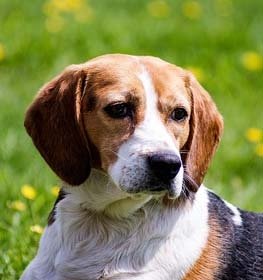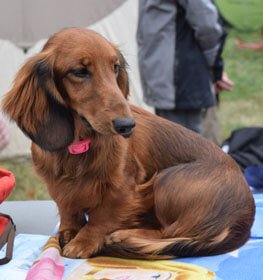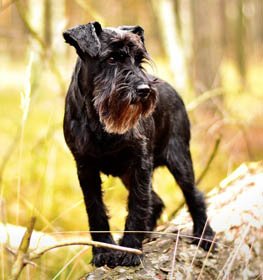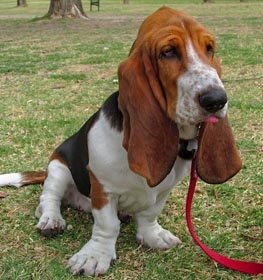Alpine Dachsbracke Information & Dog Breed Facts
Collection of all the general dog breed info about Alpine Dachsbracke so you can get to know the breed more.
| Group | Hunting Dogs |
|---|---|
| Popularity Rank | 320 |
| Reviews | 1 |
| User Ratings | |
|
Compare the Alpine Dachsbracke With Other Dogs
Select at least one dog breed to make the comparsion. | |
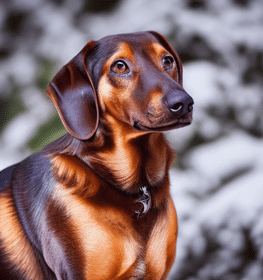 | |
| Origin | |
|
Common Names & Aliases
What other names is an Alpine Dachsbracke known by? Discover all traditional, regional and informal names used for this breed. | Alpine Basset HoundBasset des AlpesAlpenlandischer Dachsbracke |
|---|---|
|
Breed Classification
What type of dog breed is an Alpine Dachsbracke? Learn about its genetic classification and breeding category. | Purebred |
|
Size Classification
What size category is an Alpine Dachsbracke? Learn how big the Alpine Dachsbracke breed typically grows. | Small |
|---|---|
|
Weight Statistics
How much does an Alpine Dachsbracke weigh? Discover typical weight ranges for adult males and females of the Alpine Dachsbracke breed. | 33 - 40 pounds (15 - 18 kg) |
|
Average Weight
What is the average weight of an Alpine Dachsbracke? | 36,5 pounds (16,5 kg) |
|
Height
How tall is the Alpine Dachsbracke? Alpine Dachsbracke height: | 13 - 16.5 inches (34 - 42 cm) |
|
Average Height
What is the average height of an Alpine Dachsbracke? | 14,75 inches (38 cm) |
|
Price Range
How much does an Alpine Dachsbracke puppy cost? Find current market prices and factors affecting Alpine Dachsbracke costs. | $500-$700 If you choose to purchase the Alpine Dachsbracke, you should know that the mentioned amount of money is an average of the collected data from breeders’ sites and puppy finder places. If you have a Alpine Dachsbracke for sale, please advertise it on a reliable website to make sure the Alpine Dachsbracke gets to a happy place. |
|---|---|
|
Availability
How easy is it to get a Alpine Dachsbracke? How many Alpine Dachsbracke are there in the world? | Average: The Alpine Dachsbracke is a commonly available dog breed. There is less risk of overbreeding compared to the very popular dogs. Of course, they may be more popular in some countries, and inbreeding may occur, so be careful. |
|
Intelligence Rating
How intelligent is an Alpine Dachsbracke? Discover the Alpine Dachsbracke's intelligence ranking and learning capabilities. | Smart: The Alpine Dachsbracke dogs have great intelligence. They understand and memorize new commands in 15-25 repetitions.
The Alpine Dachsbracke is among the smartest dogs in the intelligence ranking. |
|---|---|
|
Training Difficulty
How easy is it to train an Alpine Dachsbracke? Learn about the Alpine Dachsbracke's trainability and response to training methods. | Alpine Dachsbracke dogs are easy to train. They find out the association between commands and actions quite quickly. |
|
Watchdog Rating
How good is an Alpine Dachsbracke as a watchdog? Learn about the Alpine Dachsbracke's alertness and guarding instincts. | Alpine Dachsbracke dogs are good watchdogs. Their main job is to observe and they're consistent in their effort. Good vocal cords and a sense of hearing belong to them. Usually, they're territorial and protective about their property, so the Alpine Dachsbracke dogs will alert you if they sense something different.
|
|
Territorial Protection
Is an Alpine Dachsbracke protective of its territory? Learn about the Alpine Dachsbracke's guarding instincts and behavior. | Alpine Dachsbracke dogs are average defenders. Some dogs are very protective of their territory, while others easily let a stranger to trespass. This breed is not sure to defend its territory in every situation. |
|
Personality Traits
What personality does an Alpine Dachsbracke have? Learn about characteristic Alpine Dachsbracke temperament and behavior traits. | IntelligentLoyalFearlessBrave |
|---|---|
|
Sensitivity Level
How sensitive are they? Alpine Dachsbracke sensitivity: | Alpine Dachsbracke dogs have an average emotional level and are not the most sensitive dog breed. Sometimes it's okay to change the daily routine, have guests and listen to loud music.
Some dogs handle moderate punishment very well, while others crumble apart at a dirty look. This breed is not affected emotionally by moderate punishment. |
|
Affection Level
How affectionate are they? Is an Alpine Dachsbracke a good family dog? | Average to High: Alpine Dachsbracke dogs are highly affectionate dogs. They like being involved in the family's life. This breed isn't considered an aloof dog. |
|
Social Needs
How much social interaction does the Alpine Basset Hound need? Alpine Dachsbracke social needs: | Alpine Dachsbracke dogs are a social breed. They enjoy being around people or other animals. This breed doesn't tolerate being left alone. |
|
Impulse to Wander or Roam
How likely is the Alpine Dachsbracke to run away? Does this breed explore or wander a lot? Does Alpine Dachsbracke roam? | Alpine Dachsbracke dogs have average wanderlust potential. Sometimes they like to explore the world and they might escape once or twice, but usually, they prefer staying safely at home. Safer to teach them how to get back to you on command. |
|
Prey Drive
Do this canine have a strong prey drive? Does Alpine Dachsbracke have high prey drive? | Alpine Dachsbracke dogs have a high impulse to chase and catch something. Cats or any other small animals are in danger. It's a natural instinct, doesn't necessarily mean that Alpine Dachsbracke dogs are aggressive. Better to keep this breed on a leash. |
|
Barking Frequency
Does an Alpine Dachsbracke bark a lot? Learn about typical Alpine Dachsbracke vocalization patterns and triggers. | Average: The Alpine Dachsbracke barks occasionally. They can change their barks depending on their emotional level and what they're trying to say. Different barks could mean the same and the same barks could have different meanings.
Top reasons for barking: protection, alarm, fear, boredom, attention-seeking, greeting, separation anxiety, compulsive barking. |
|---|---|
|
Playful Nature
How playful is an Alpine Dachsbracke? Understand the typical play drive and energy level of the Alpine Dachsbracke breed. | Average: Alpine Dachsbrackes, like any other dog breed, like playing. Sometimes they bark in excitement for playing, but they are not the most playful dog breed. |
|
Apartment Adaptability
Can an Alpine Dachsbracke live in an apartment? Learn about the Alpine Dachsbracke's suitability for apartment living. | Apartment-friendly dog the Alpine Dachsbracke breed. It is best if you have a small garden where it can occasionally go out to do its business, but this is not important at all. You can exercise him enough with a walk or two a day, so he's comfortable in an apartment. |
|
Lifestyle Adaptability
How adaptable is an Alpine Dachsbracke to lifestyle changes? Learn about the Alpine Dachsbracke's flexibility to new situations. | Alpine Dachsbracke dogs adapt well to lifestyle changes and different living environments. They don't mind moving from one place to another with their owner. |
|---|---|
|
Alone Time Tolerance
Can an Alpine Dachsbracke be left alone? Learn about the Alpine Dachsbracke's tolerance to solitude. | Alpine Dachsbracke dogs do best when a family member is at home during the day or if their workplace is dog-friendly so they can take the dog at work. |
|
Bite Risk Assessment
What is an Alpine Dachsbracke biting potential? Learn about the Alpine Dachsbracke's bite risk factors. | Low 🔽 The Alpine Dachsbracke has a low chance of biting somebody. Top reasons for dog bite: protection, pain, excitement, herding instinct, being provoked. (Data based on the available online bite statistics.) |
|---|---|
|
Mouthing Tendency
Is an Alpine Dachsbracke mouthy? Learn about the Alpine Dachsbracke's tendency to use mouth during play. | Alpine Dachsbracke dogs have an average tendency to nip, chew, playbite, or herd people. It's a common habit during puppyhood, not aggressive behavior. These "bites" don't hurt, but Alpine Dachsbracke dogs need to be taught a good attitude. |
|
Bite Strength Rating
How strong is an Alpine Dachsbracke bite? Learn about the Alpine Dachsbracke's bite force measured in PSI. | Between 100 and 200 PSI 🔽 Alpine Dachsbracke bite force: Weak. The Alpine Dachsbracke bite force is considered weak when compared to other dog breeds. The bite force Alpine Dachsbracke measurements usually fall below 200 PSI, making them one of the breeds with the weakest bite force. The bite force of an Alpine Dachsbracke may be weak, but it's important to remember that any dog's bite can still be dangerous if not managed properly. Despite the bite force of Alpine Dachsbracke being lower, it does not make them any less lovable or enjoyable as pets.
Alpine Dachsbracke bite wounds might not be as severe, but it is still essential to be cautious and prevent any biting incidents. They are usually not aggressive and very friendly towards children and other animals. To ensure a well-behaved dog, it's essential to learn how to train an Alpine Dachsbracke puppy not to bite from an early age. With proper training and socialization, an Alpine Dachsbracke can be a wonderful addition to any family, providing love and companionship for years to come. |
|
Average Lifespan
How long does an Alpine Dachsbracke live? Learn about the typical lifespan of the Alpine Dachsbracke breed. | 11-13 years The average lifespan of Alpine Dachsbracke: 12 years |
|---|---|
|
Climate Tolerance
How well does an Alpine Dachsbracke handle different weather? Learn about the Alpine Dachsbracke's climate adaptability. | Prefers average to cold weather conditions The Alpine Dachsbracke can adapt to well to cold weather conditions, some dogs even can be a good mountain dog. |
|
Health Concerns
What health issues are common in an Alpine Dachsbracke? Discover typical conditions affecting the Alpine Dachsbracke breed. | The Alpine Dachsbracke is a healthy breed, but there are certain health issues that you should check with your vet regularly. |
|
Vet Care Frequency
How often does an Alpine Dachsbracke need vet visits? Learn about the Alpine Dachsbracke's veterinary care requirements. | Average The Alpine Dachsbracke should have a complete physical check-up at least once per year. If your dog shows any symptoms, call your veterinarian. |
|
Health Problems
What genetic/health problems does the Alpine Dachsbracke breed have? What are the health issues and concerns of the Alpine Dachsbracke breed? Most common health risks of Alpine Dachsbracke: | Patellar LuxationDrug SensitivityEar InfectionsIntervertebral Disk Disease |
|
Energy Rating
How energetic is an Alpine Dachsbracke? Understand daily activity needs of the Alpine Dachsbracke breed. | Alpine Dachsbracke dogs are high-energy dogs. An active lifestyle makes them happy. |
|---|---|
|
Activity Requirement / Exercise Need
How much exercise does an Alpine Dachsbracke need? How much exercise do Alpine Dachsbracke dogs require per day?
Do Alpine Dachsbracke dogs need a lot of exercises? | Alpine Dachsbracke dogs have an average exercise need. This breed is satisfied with short walks every weekday and a long ones on weekends. |
|
Sleeping Need
How much sleep does the Alpine Dachsbracke breed need? | Alpine Dachsbracke dogs don't need too much sleep. They are energetic and desire to live active life. If you think naps are overrated, this breed can be the best choice for you. |
|
Obesity Tendency
Is an Alpine Dachsbracke prone to weight gain? Learn about the Alpine Dachsbracke's obesity risks. | High: The Alpine Dachsbracke breed has a strong tendency to be overweight. Try to find the happy medium between exercise and feeding. If you want to keep balance, increase the amount and frequency of your daily dog walk and play with the Alpine Dachsbracke more often.
If you notice any weight gain, consult your veterinarian and make a diet plan. Reduce unhealthy food and snacks, and measure the Alpine Dachsbracke weight regularly. |
|---|---|
|
Food Consumption
How much food does an Alpine Dachsbracke need daily? Learn about the Alpine Dachsbracke's feeding requirements. | 1/2 to 1 1/2 cups of high-quality dry food a day. |
|
Allergy Friendliness
Is an Alpine Dachsbracke hypoallergenic? Learn about the Alpine Dachsbracke's suitability for allergy sufferers. | No Alpine Dachsbracke dogs don't do well with allergy sufferers by causing allergic reactions. Some dog breeds are even considered to higher possibility of an allergic response. Coat type isn't necessarily relevant, because most people are allergic to dander (flakes on the dog's skin) or saliva, not actually to dog hair. |
|---|---|
|
Coat Colors
What colors does an Alpine Dachsbracke come in? Discover all possible Alpine Dachsbracke color variations. | Dark deer red |
|
Grooming Requirements
How much grooming does an Alpine Dachsbracke need? Learn about Alpine Dachsbracke coat maintenance requirements. | Easy to groom: The Alpine Dachsbracke doesn't require a lot of grooming. Seasonal flea treatment is needed, but cutting the dog's hair by a professional groomer isn't necessary. Ears and eyes should be cleaned regularly to avoid infections. Alpine Dachsbracke is a good choice if you don't have the time, skill, or money to take care of a high-maintenance dog. Recommended for beginners. |
|
Drooling Tendency
Does an Alpine Dachsbracke drool a lot? Learn about the Alpine Dachsbracke's drooling habits. | The Alpine Dachsbracke is a perfect example of a very low drooling tendency. If you're disgusted by slobber spots on your clothes, the Alpine Dachsbracke could be a perfect choice for you. Drooling is the unintentional saliva flowing outside of the mouth. It can be completely normal or a sign of a health problem. Certain dog breeds drool minimum compared to others, just like the Alpine Dachsbracke.
If you notice any change in your dog's drooling habit, you should contact a vet as soon as possible. |
|
Stinkiness Rating
Does an Alpine Dachsbracke smell bad? Learn about the Alpine Dachsbracke's natural odor levels. | Medium ⏺ The Alpine Dachsbracke has an average chance of bad smell. Top reasons for dog stinkiness: infection of bad tooth/ear/skin folds, gas attacks. |
|
Coat Characteristics
What type of coat does an Alpine Dachsbracke have? Learn about the Alpine Dachsbracke's fur characteristics. | DenseThickSmooth |
|
Bathing Needs
How often does an Alpine Dachsbracke need baths? Learn about the Alpine Dachsbracke's bathing requirements. | 6-8 weeks Rarely. Bathing your dog is beneficial to them in more ways than just one. It’s also a good time to look for unusual scratches, bumps, fleas, and other irregularities. When their hair is wet and flat against their body, these details are more visible.
For example, short-haired dog breeds can go a very long time in between baths. These short-haired breeds shed regularly and that shedding works to naturally remove excess dirt and oil. So unless your weenie dog got into the garbage can, you can probably hold off on a bath for a while. |
|
Shedding Level
How much do Alpine Dachsbracke dogs shed? How to control, reduce and prevent the shedding of the Alpine Basset Hound? Do Alpine Dachsbracke dogs shed a lot? | Alpine Dachsbracke dogs shed none to minimal. Having a puppy from this breed you don't have to be afraid of your couch or car being covered by dog hair. Alpine Dachsbracke dogs could be the best choice if you don't tolerate dog hair. |
|
Child Compatibility
Is an Alpine Dachsbracke good with children? Learn about the Alpine Dachsbracke's behavior around kids of different ages. | Alpine Dachsbracke dogs are not the most kid-friendly dogs. If you have children, you may have to reconsider your choice of having a puppy from this breed.
|
|---|---|
|
Pet Compatibility
How well does an Alpine Dachsbracke get along with other pets? Discover the Alpine Dachsbracke's compatibility with other animals. | Alpine Dachsbracke dogs are generally with other pets. |
|
Stranger Friendly
Are they aggressive or friendly towards/with strangers? Alpine Dachsbracke temperament with other people: | Alpine Dachsbracke dogs are not the most stranger-friendly dogs. |
|
Cat Friendly
How well do Alpine Dachsbracke dogs get along with cats? Are they good with kittens? What is this fido's temperament with cats? Can they be good with cats? Can the Alpine Dachsbracke breed live with a cat? | Alpine Dachsbracke dogs are average friendly towards cats. |
|
Dog Friendly
Is Alpine Dachsbracke good with other dogs? Are they dog-friendly dogs? How well do Alpine Dachsbracke dogs get along with other dogs? | Alpine Dachsbracke dogs are not the most dog-friendly dogs. If you want more dogs in your family or you'd like to join dog meetups, the Alpine Dachsbracke is not a good choice. |
|
Good For First Time Owners
Is Alpine Dachsbracke breed good for first-time owners? Do they make a good dog for novice owners? Is Alpine Dachsbracke breed suitable for first-time owners? | Yes Alpine Dachsbracke dogs are good for novice owners, due to their easy-going personality. |
|
Office Friendly
Are Alpine Dachsbracke dogs good office canines? Do Alpine Dachsbracke dogs make good office-friendly pets? Can they be office dogs? | No Alpine Dachsbracke is not the best dog breed for office environment. |
|
Senior Citizens Friendly
Are they senior citizens friendly dogs? How well do Alpine Dachsbracke dogs get along with the elderly people? What is the Alpine Basset Hound temperament with senior people? Are Alpine Dachsbracke dogs good for elderly owners? | Alpine Dachsbrackes are not the best breed for elderly people. |
|
Service Dog Capability
Can an Alpine Dachsbracke be a service dog? Learn about the Alpine Dachsbracke's service work potential. | Not really This breed generally not used as a service dog. A service dog is a term used in the USA to refer to any type of assistance dog specifically trained to help people who have disabilities, such as visual impairment, hearing impairments, mental disorders, seizures, mobility impairment, and diabetes. Service dogs are protected under the ADA (Americans with Disabilities Act).
Alpine Dachsbracke is not the best breed for service purposes. |
|---|---|
|
Therapy Work Suitability
Is an Alpine Dachsbracke good as a therapy dog? Learn about the Alpine Dachsbracke's therapy work aptitude. | Not really This breed is generally not used as a therapy dog. A therapy dog is a dog that might be trained to provide affection, comfort, and love to people in hospitals, retirement homes, nursing homes, schools, hospices, disaster areas, and people with anxiety disorders or autism.
Alpine Dachsbracke is not the best breed for therapeutic purposes. |
|
Scent Detection Ability
Is an Alpine Dachsbracke good at detection work? Learn about the Alpine Dachsbracke's scenting abilities. | Not really They are not typically employed for this type of work, but there may be exceptional cases. A detection dog or sniffer dog is a dog that is trained to use its senses (mostly its smell) to detect substances such as explosives, illegal drugs, wildlife scat, currency, blood, and contraband electronics such as illicit mobile phones.
Alpine Dachsbracke is not the best breed for detection purposes. |
|
Search & Rescue Potential
Can an Alpine Dachsbracke do search and rescue? Learn about the Alpine Dachsbracke's SAR capabilities. | Not really This dog breed is not typically used as a search and rescue dog. The use of dogs in search and rescue (SAR) is a valuable component in wilderness tracking, natural disasters, mass casualty events, and locating missing people.
The Alpine Dachsbracke is not the best breed for SAR purposes. |
|
Maritime Work Ability
Is an Alpine Dachsbracke good on boats? Learn about the Alpine Dachsbracke's maritime capabilities. | Not really Alpine Dachsbracke breed usually doesn't like being on a boat. Boat dogs were typically bred for their strength, stamina, and water resistance, as they were often required to perform tasks such as pulling in fishing nets, and jumping into the water to retrieve ropes or lines, or helping to move cargo. Sailor dog is a type of dog that was bred to accompany sailors on their voyages. They were typically used for three purposes: as a working dog, a watchdog, and as a companion. A boat dog is a term used to describe a type of dog that was traditionally bred and used as a working dog on boats. |
|
Draft Work Capability
Can an Alpine Dachsbracke pull carts? Learn about the Alpine Dachsbracke's drafting abilities. | Not really A drafting dog or draft dog is a dog bred and used for cart pulling. Dogs bred for this work have strong builds and qualities that are needed, strength and determination.
Alpine Dachsbracke is not the best breed for drafting purposes. |
|
Military Service Background
Was an Alpine Dachsbracke used in military service? Learn about the Alpine Dachsbracke's military history. | Not really In history, this breed was not really used for combat dog. |
|
Puppy Litter Size
How many puppies does an Alpine Dachsbracke usually have? Learn about typical litter sizes. | 3-5 puppies |
|---|---|
|
Pregnancy Duration
How long is an Alpine Dachsbracke pregnant? Learn about the Alpine Dachsbracke's gestation period. | 60-64 days Reproductive cycle of the female Alpine Dachsbracke: The first period called Proestrus lasts for about 9 days.
During this time the females start to attract males. You can notice by swelling vulva and bloody discharge. The second part is the Estrus when the female is receptive for the male. It lasts for about 3 to 11 days. The sign of the proestrus part is the soft and enlarged vulva. The discharge decreases and lightens in color. The third part is the Diestrus. Normally, it occurs around day 14. In this period the female’s discharge changes for vivid red and coming to its end. The vulva returns to average, and she will no longer permit mating. The fourth part called the Anestrus. The time frame between heat periods normally lasts about six months. |
|
Breeding Frequency
How often can an Alpine Dachsbracke have puppies? Learn about safe breeding intervals. | Once a year. More frequent breeding is not healthy. It is very important not to buy a dog from a puppy mill, where the needs of the pups and their mothers are ignored. It's an inhumane high-volume dog breeding facility, where puppies born several times a year. |
|
AKC Classification
What AKC group is an Alpine Dachsbracke in? Learn about the Alpine Dachsbracke's AKC classification. | Not recognized by the American Kennel Club. |
|---|---|
|
FCI Classification
What FCI group is an Alpine Dachsbracke in? Learn about the Alpine Dachsbracke's international classification. | Recognized by FCI in the Scent hounds and related breeds group, in the Leash (scent) Hounds section. |
|
Kennel Club Recognition
Which kennel clubs recognize an Alpine Dachsbracke? Learn about the Alpine Dachsbracke's official recognition. | American Canine RegistryAmerica's Pet RegistryDog Registry of America Inc.Federation Cynologique InternationaleAmerican Canine Association, Inc.Continental Kennel ClubNational Kennel Club |
Alpine Dachsbracke Pros and Cons
- Intelligence Rating: Smart: The Alpine Dachsbracke dogs have great intelligence.
- Training Difficulty: Alpine Dachsbracke dogs are easy to train.
- Apartment Adaptability: Apartment-friendly dog the Alpine Dachsbracke breed.
- Grooming Requirements: Easy to groom: The Alpine Dachsbracke doesn't require a lot of grooming.
- Shedding Level: Alpine Dachsbracke dogs shed none to minimal.
- Drooling Tendency: The Alpine Dachsbracke is a perfect example of a very low drooling tendency.
- Watchdog Rating: Alpine Dachsbracke dogs are good watchdogs.
- Lifestyle Adaptability: Alpine Dachsbracke dogs adapt well to lifestyle changes and different living environments.
- Good For First Time Owners: Alpine Dachsbracke dogs are good for novice owners, due to their easy-going personality.
- Allergy Friendliness: Alpine Dachsbracke dogs don't do well with allergy sufferers by causing allergic reactions.
- Obesity Tendency: High: The Alpine Dachsbracke breed has a strong tendency to be overweight.
- Alone Time Tolerance: Alpine Dachsbracke dogs do best when a family member is at home during the day or if their workplace is dog-friendly so they can take the dog at work.
- Child Compatibility: Alpine Dachsbracke dogs are not the most kid-friendly dogs.
- Dog Friendly: Alpine Dachsbracke dogs are not the most dog-friendly dogs.
- Office Friendly: Alpine Dachsbracke is not the best dog breed for office environment.
- Senior Citizens Friendly: Alpine Dachsbrackes are not the best breed for elderly people.
Alpine Dachsbracke History
The Alpine Dachsbracke, also known as the Alpenlandische Dachsbracke in its native country of Austria, was specifically bred to assist hunters by tracking wounded deer, boar, hare, and fox. At the time of the breed’s creation, there was a need for a hard-working, motivated dog with a good nose capable of following a trail even after it had gone cold, while also being able to survive in the harsh climate in the high altitudes of the Alps.
The breed has received its iconic scenting ability from the Austrian Black and Tan Hound and also the durability necessary to survive and function at a high level in the mountainous terrain. The Austrian Black and Tan Hound are considered to be an ancient breed, and it is also part of a group of dogs known as Grand Brackes. A group that includes the Tyrolean hound and the Styrian Coarse-Haired Hound, all of which were specifically developed over numerous centuries to hunt. It was these mountain dog genes that the developers of the Alpine Dachsbracke wanted to embody in their creation. Moreover, the breed gained its short stature, courage, determination, and an exceptionally high prey drive from the
Dachshund. Known as the original Badger dog, this breed is a natural courageous hunter. By breeding these two distinctly unique breeds, the Dachshund and the Austrian Black and Tan Hound, they were able to create a dog that had the best attributes of both, while limiting the negative features of either, such as the mobility problems the Dachshund short legs would have provided, or the lower prey drive and tenacity of the Austrian Black and Tan Hound. Although the breed was bred to be quite short, it was developed to be slightly bigger than its German counterpart the Westphalian Dachsbracke. Moreover, the combination proved to be successful, that the Alpine Dachsbracke became the favorite of the hunters. It is documented that Crown Prince Rudolf of Habsburg, the archduke of Austria and heir to the throne, specifically instructed his gamekeepers to ensure that these dogs were included on his hunting trips to Egypt and Turkey in 1881 and 1885.
Furthermore, in 1932 the widespread use of the breed and its success resulted in its recognition as the third scent hound breed by the top Austrian canine organizations of the time. In 1975, the name was changed from Alpine-Erzgebirgs-Dachsbracke to Alpine Dachsbrake when the Federation Cynologique Internationale recognized the breed and declared Austria to be its origin. In 1991 the FCI placed the breed in Group 6 Scenthounds, Section 2 “Leash Hounds” with the Hanoverian Scenthound and the Bavarian Mountain Scenthound.
The Alpine Dachsbracke is primary a hunting dog, however, modern times have decreased the need for individuals to hunt for income or survival which reduced the dogs’ roles for this purpose. Today, hunting with this breed is primarily a game of sport performed at localized gatherings by small clubs and groups of fanciers. The breed has also moved into the role of being kept as a house pet and companion. The breed is also recognized by the United Kennel Club, in their Scenthound Group.
Latest Alpine Dachsbracke Compares
Alpine Dachsbracke Names
How old is my Alpine Dachsbracke in human years?
You May Also Like
Rate The Alpine Dachsbracke Breed
Alpine Dachsbracke Comments, Reviews and Questions
- Kiwi
Aug 12, 2022, 11:07:57 AM:
Extremly independent,affectionate,intelligent but stubborn,calm and protective of their own. Great hunting dogs. Always ready for fun and cuddling. Not best family dogs,but if given enough exercise they does fine.

